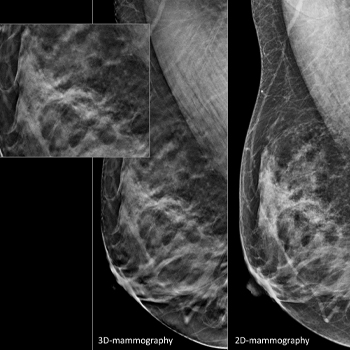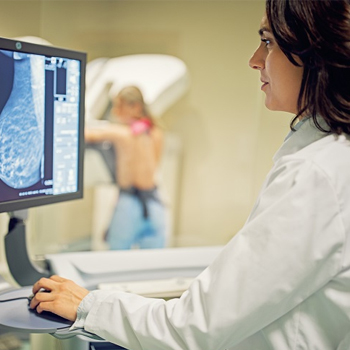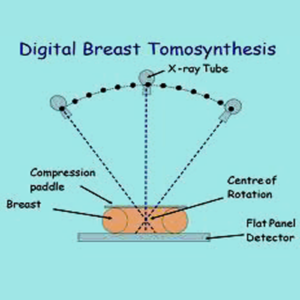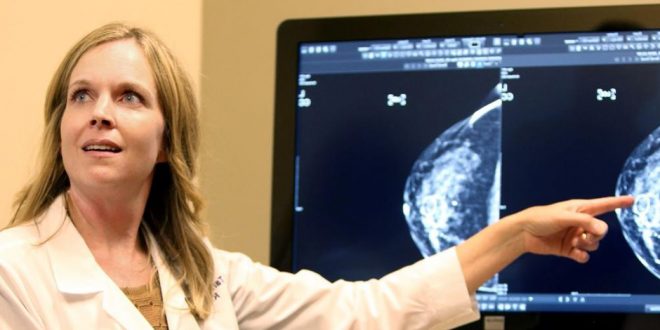Tomosynthesis is a technology in radiology wherein instead of producing flat images as you would in traditional x-rays, the x-ray tube moves in an arc around the subject instead, taking slices of images from multiple angles to produce a 3D image.
Here’s everything you need to know about Digital Breast Tomosynthesis and why you should choose RadComm for the mandated MQSA DBT training requirement.
What is Digital Breast Tomosynthesis?
Digital Breast Tomosynthesis (DBT) is an advanced form of mammography, wherein instead of producing flat 2D images in traditional mammography, 3D images are instead created.
This procedure uses the same technology as traditional mammography, but it overcomes some limitations that the conventional method may have.

Overlapping tissue is one of the most common. In traditional 2D mammography, the radiologic technologists will take images from two angles of each patient’s breast: top to bottom and side to side. The radiologist will then view the flat images to create a liking of the customer’s breasts. Breast tissues will possibly overlap when using this method, which can potentially hide breast cancer. Consequently, the same overlapping can show lumps or masses that seem abnormal but might just be false positives.
On the other hand, DBT takes 3D images of the patient’s breasts. The x-ray tube moves in an arc around each breast (instead of up and down, side to side), taking images from multiple angles. The machine transfers the images to a computer that assembles them to produce slice images of the breast.
Mammographers are highly satisfied with DBT as a screening method and consider it more accurate in prognosis than traditional mammography. Most physicians and doctors will request some form of a combination of 2D mammography and 3D tomosynthesis during breast screening.
As per the policy guidance system, the FDA has approved DBT for breast screening in 2017, and it has quickly become the standard screening method for breast cancer detection. Most hospitals have quickly integrated this technology into their existing mammography procedures.
Training Essentials

Course Overview
Digital Breast Tomosynthesis courses are intended for radiology and mammography professionals who wish to practice DBT or work in a facility that uses this technology. These will educate you on the fundamentals of the new technology in mammography and teach you how to properly and successfully implement them in your clinical practice.
The course will also fulfill the 8-hour MQSA mandated requirement before working in a radiology clinic that performs DBT.
Course Outline
DBT courses are broken down into two categories: 6-hour didactic classes in the form of online or sit-down classes and a 2-hour on-site clinical training if your facility is already performing DBT.
The courses will cover the following:
- Understanding the fundamentals of Digital Breast Tomosynthesis
- Understanding the difference between traditional 2D mammography and DBT and why there are “only on DBT findings”
- Identifying staff requirements for practice
- Implementing application processes unique to DBT equipment
- Applying DBT fundamentals and learnings as deemed necessary by operational needs
- Applications of use and image creation unique to DBT units approved by the FDA (GE, Siemens, Fujifilm, and Hologic)
Introduction
DBT courses will introduce you to the exciting and brand new technology surrounding 3-D mammography, its unique physics and technique, as well as interpretation of data. This will prepare radiologic technologists and mammographers for the growing demand of implementing DBT in most radiology clinics by teaching fundamentals, utilization, and its benefits.

System Operation
The courses will teach you how to operate FDA-approved Digital Breast Tomosynthesis units (GE, Siemens, Fujifilm, and Hologic). There will notably be slight differences in each system, but as long as you fulfill general DBT training or have been exposed to using one brand of DBT system, the MQSA will recognize them as having met the training requirements.
Also Read: Proper Positioning Tips for CC & MLO Views
Clinical Practice
The MQSA does not require clinical practice if you won’t be working in a facility with DBT; however, it’s best if you get one. The clinical practice will give you hands-on experience in handling DBT units, from image production, operation, quality control, and troubleshooting.
Where to Get Tomosynthesis Training
RadComm offers Digital Breast Tomosynthesis training that fulfills the requirement for the 8-hour initial DBT training requirement by the MQSA before you are allowed to practice. It consists of 6 hours in online courses and classes, with 2 hours of on-site clinical training under the guidance of a qualified DBT technologist, which will only be necessary if the facility you’re working for is practicing DBT.

Otherwise, the 6-hour training classes and modules will suffice the MQSA requirement.
Upon completion, you will be granted a DBT Certificate of Completion. This training is equivalent to 6 CE credits required by the American Registry of Radiologic Technologies (ARRT).
FAQS
Yes, tomosynthesis is the same as 3D mammography. To be more specific, tomosynthesis refers to the umbrella term for an x-ray done in 3D. Clinical applications of tomosynthesis include vascular, dental, orthopedic, musculoskeletal, chest, and, of course, mammographic.
Plenty of studies have been done on tomosynthesis ever since it was introduced in healthcare. One study tested two groups of women: 50,000 of which were screened using DBT and 130,000 using traditional mammography. They were able to determine that overall, DBT had better accuracy and prognosis when detecting cancer, regardless of the woman’s age or breast density. [1]
Key Takeaways
Digital breast tomosynthesis is only one of the many innovative and fresh changes in the medical field, and its efficacy is rarely questioned. After all, early detection and treatment of cancer have been attributed to successful mammography over the years, and we can only assume the same for DBT.
This means that plenty of new training guidelines, rules, and regulations will need to be implemented when handling modern DBT units, which is why you need supplemental training in accredited mammography schools. Get in touch with us at RadComm today to know more about our Digital Breast Tomosynthesis Course and other exciting training programs.

Digital Breast Tomosynthesis Continuing Education Course
References:
- https://www.arrt.org/


